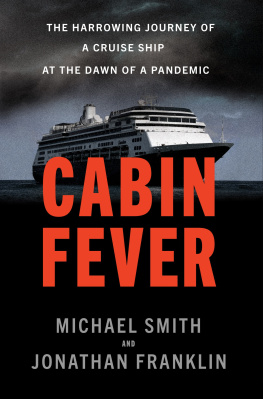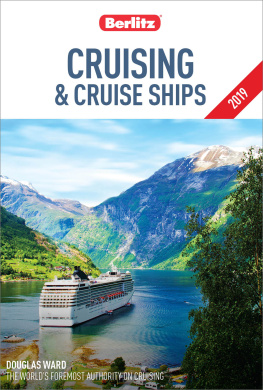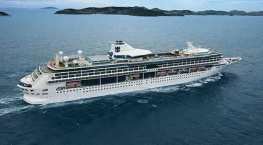British Library Cataloguing in Publication Data A catalogue record for this book is available from the British Library
All rights reserved. No part of this publication may be reproduced or transmitted in any form or by any means, electronic or mechanical, including photocopying, recording, or any information storage and retrieval system, without prior permission in writing of both the copyright owner and the above publisher.
The right of Aaron Saunders to be identified as the author of this work has been asserted by him in accordance with the Copyright, Designs and Patents Act 1988.
Typeset and designed by Roger Daniels Printed and bound in China through Printworks International Ltd.
Acknowledgements
This book would not have been possible without the kind assistance of people who are as dedicated to cruising and cruise ships as I am. I owe them an enormous debt of gratitude for providing me with photographs, interviews, ideas, and even the odd coffee or two. Some of them Ive only spoken to over countless emails and phone calls, while others have welcomed me into their homes and lives with open arms.
They gave me the world when I asked for a favour, and for that I am eternally grateful. They are: Brad Ball, Yvette Batalla, Mindy Bianca, Vanessa Bloy, Bart de Boer, Jackie Chase, Laurel Davis, Janet Diaz, Frans Dingemans, Erik Elvejord, Gina Finocchiaro, Elliot Gillies, Bruce Good, Ralph Grizzle, Vance Gulliksen, Torstein Hagen, Nina Helland, Ian Jeffries, Jennifer Kaake, Peter Knego, Vanessa Lane, Aileen Laurel, Jason Leppert, Ann Marie Matthews, Gail Nicolaus, Rebeka Pevec, Kimberly Plumridge, Adrian Raeside, and Maureen and Peter Saunders.
For those who share the same insane love of cruise ships, there are plenty of online resources available from talented people who really have devoted themselves, both professionally and personally, to documenting these beautiful vessels.
Avid Cruiser: www.avidcruiser.com
MaritimeMatters: www.maritimematters.com
Popular Cruising: www.popularcruising.com
ShipParade: www.shipparade.com
Introduction
Ones destination is never a place, but a new way of seeing things.
HENRY MILLER

I FIRST became interested in cruising and cruise ships in 1992, when my parents took my sister and I on a vacation in the interior mountains of British Columbia, Canada. Along the way, we stayed at a small motel in an even smaller town, known as Three Valley Gap, which most people just zip past on their way between Revelstoke and Salmon Arm. And while the motel was nothing to write home about, it did have one defining feature: a swimming pool designed to look like that found on a transatlantic passenger liner of a bygone era, complete with a mural of RMS Titanic painted on its wall.
Now, I have no idea why a land-locked motel would paint a mural of the worlds most famous shipwreck on the wall of their swimming pool, but it did the trick: I spent the rest of the trip going into bookshops and seeking out any materials I could find on ocean liners and cruise ships. Couple that with a grandmother who spent much of her retired days sailing to Alaska aboard the ships of Holland America Line, and youve got the recipe for a cruise addict.
Like most addictions, reading about cruises led to taking numerous cruises and even planning entire trips around cruise ships. Perhaps not surprisingly, it was only a matter of time before I began writing about them, too.
Its a miracle my friends and family still speak to me.
But I came to realise that while there were many books dedicated to the legendary transatlantic greyhounds, few were devoted to the stunning cruise ships that were sailing out of the shipyards in Europe and Asia, revolutionising not only shipbuilding technology but also the cruise industry itself. In fact, the stunning growth that has occurred in the past two and a half decades is similar to the same building race that gripped the shipping world over a century ago.
During the latter half of the 1800s and the beginning of the twentieth century, a race for supremacy was playing out on the oceans of the world, and its epicentre was the lucrative Atlantic crossings that routinely took wealthy guests from England to America, along with thousands of immigrant passengers who made up third class, which was also known as steerage. It was these immigrants that would make up the bread and butter for famous shipping lines such as Cunard, Hamburg America and White Star.

A young boy plays out on deck on P&Os Orcades during a 1950s voyage. The onset of the jet age would severely limit the number of ocean liners plying the waters of the world.
(ADRIAN RAESIDE)
Just moving passengers around the massive Carnival Destiny required some dedicated thought. In order to smooth out passenger flow between decks, Carnival Destiny was equipped with twenty-seven Schindler lifts, and eighteen of these were for guest use and spread across three main lift banks.
Another area that Carnival was eager to thrust into centre stage on Carnival Destiny was her sprawling, 15,000sq ft spa overlooking the bow. In an age when many ships still considered spa facilities something of an afterthought, the spa on Carnival Destiny would include a full salon, treatment rooms, a pair of whirlpools, and a fully-equipped gymnasium. Personal trainers were on hand to help guests with their daily fitness regimen, and a jogging track was conveniently located just outside on Deck 11, where runners could do laps in the shadow of Carnivals signature funnel.
Moving the largest cruise ship in the world required some suitably major horsepower. She was powered by six Sulzer medium-speed diesel generator engine sets, four of which were 16-cylinder, each with an output of 11,520kW, and two each rated at 8640kW. In addition to her dual shaft-driven propellers, Carnival Destiny had six thruster units to help with manuvring procedures. Three were mounted forward, with an additional three located aft. Each featured variable-pitch propellers driven by a single 1720kW motor.
Carnival Destiny was also fitted with twenty-two Schat-Harding MPC32 partially-enclosed lifeboats, each capable of holding up to 150 persons. These were mounted to special, under-deck davits that contained a telescopic arm rather than more traditional davits that swing out. Because of these space-saving telescopic davits, lifeboats could be tucked in snugly above Carnival Destiny s segmented Promenade Deck and still comply with Safety of Life at Sea (SOLAS) convention regulations that mandated a common height of 49ft above the waterline for all lifeboats carried aboard passenger ships. Destiny wasnt the first cruise ship to make use of these new davits, but it was the first to put them to use aboard a passenger ship of her size. Two smaller Schat-Harding lifeboats are rigged at the forwardmost end of the ship.






















